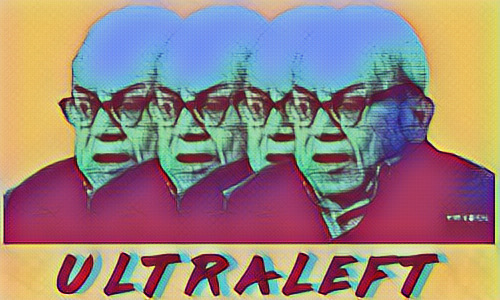Three Points of Mao-Spontaneity
Anarcho-Maoism combines anarchist and Maoist ideals. It is particularly inspired by the Cultural Revolution when revolt against all organized society was encouraged. The ideas of anarchomaoism can best be summed up with the phrase “to rebel is justified.” Mao-spontenaity emphasizes the chaotic aspects of Maoist revolution in opposition to status quo and established order. Anarchomaoism is influenced by elements of direct democracy.
Its important to note that Mao was a mass-murdering statist, who murdered more people than anyone else in history, including Hitler and Stalin. He used intimidation, prisons, police, concentration camps, and bogus trials to terrorize and murder countless people. “Maoism” in the traditional sense is authoritarian. However many aspects of Maoist philosophy is worth salvaging. Nothing is “entirely good” or “entirely bad”, everything has something to offer us, so take the good parts of Maoism and discard the rest. Also, there is a big difference between Mao’s regime and the popular masses that fervently worked to create a free society.
But regardless of the authoritarian legacy which we ordinarily associate with Maoism and the Chinese Revolution, the experiences of China are seen by the people as new, adventurous, bold, courageous and daring, and as the dawn of a new way of life, of a new world-view and way of looking at the world, a truly liberatory social experiment from the bottom-up.
The 3 Points of Mao-Spontenaity
- Cultural Revolution
“Revolution within the revolution.” Maoism sees revolution as being a continual on-going process, rather than one big cataclysmic event, as a lot of anarchists conceive it. This is why the Chinese Cultural Revolution lasted 10 years! The victory of The Revolution or Civil War is not the end of the revolution, but only the beginning – and developments need to be continually made in all areas of life, in science, philosophy, economics, agriculture, culture, and interpersonal relations, always pushing the envelope, and all of these developments exist to increase human happiness and provide for everyone’s needs, wants, and desires. This dynamic optimist approach “acts as a potent psycho-epistemological vaccine, not only against pessimism and defeatism, but against dogmatization and stagnation, and so encourages [.] openness to new information and approaches”
- Law of Contradictions
Mao suggests that all movement and life is a result of contradiction. Mao describes existence as being made up of constant transformation and contradiction. Nothing is constant as in metaphysics and can only exist based on opposing contradictions. Maoist epistemology, his ideas on “criticism/self-criticism” in particular. There are many parallels between this and critical rationalist Karl Popper’s “conjectures and refutations”. This means critiquing, rooting out and examining all irrationality, mysticism, authority, and domination, and a constant process of rational criticism and reflection. Maoist epistemology also sees coercion as being harmful to the growth of knowledge, and sees this as best being done through non-coercive means, such as persuasion and criticism. Mao writes: “The only way to settle questions of an ideological nature or controversial issues among the people is by the method of discussion, of criticism, of persuasion and education, and not by the method of coercion or repression.”
- Mass Line
Mao payed little importance to the supposed necessity of industrial and technological development as being a prerequisite for revolution, an idea inherited from orthodox Marxist economic determinism. He conceived of revolution as not being determined by history, technology or anything else, but as being based on a sheer force of will on the part of people who desire it and are determined to make it happen. Mao’s concept of “from the people, to the people.” He argued that the revolutionary vanguard (used in a non-authoritarian sense, meaning “an advanced minority”) should go directly to the people, to the villages, towns, and communities – live and study first-hand the life of the people, talk with everyday people, and find out their needs, desires, goals, aspirations, talents, capabilities, ideologies, and mindsets, and then formulate the revolutionary theory in a way that people can understand and that deeply resonates with them and their everyday life. Here is how Mao describes “from the masses, to the masses.”
Mao characterized himself as “having both some of the spirit of the tiger which is dominant, but also some of the spirit of the monkey, which is secondary.” Using Mao’s famous self-commentary “part tiger, part monkey” we can see into Mao’s Law of Contradictions. The tiger represents the establishment centralized powers. The monkey represents rebelliousness and challenge to authority. The constant opposing forces come to play in the law of contradictions. These opposing forces are always present, the feat is to harness the balance of both. Mao sought to reconcile the top down and bottom up elements of a revolutionary movement.
Mao knew the tiger faction would win out after his death. What is needed is to revive the monkey spirit of anarcho-Maoism which keeps the upwelling of the people’s power critical to the movement. Mao-spontaneity also accounts for cultural revolution which seeks to have the populace rebel against the centralized party apparatus itself. Additionally, the essential element of the mass line is consulting the masses interpreting their suggestions and then enforcing the resulting policies. This direct democratic approach is where the bottom up versus top down dichotomy comes to a culmination.




Comments
Post a Comment